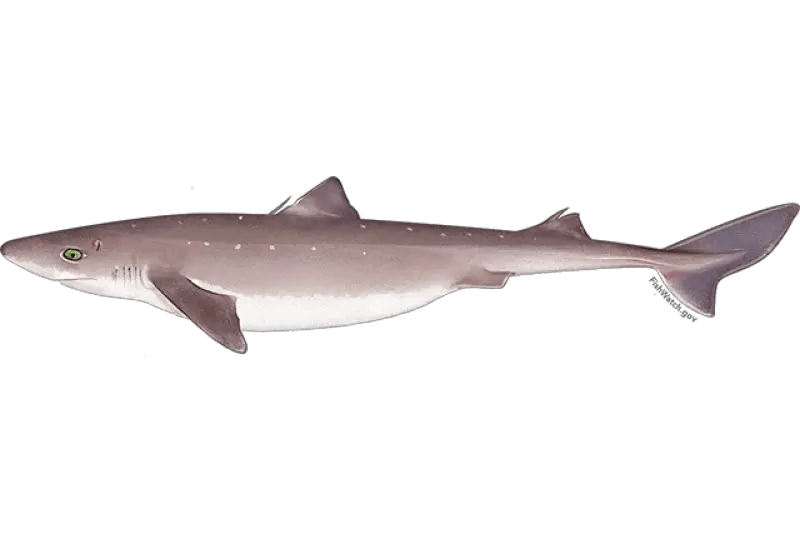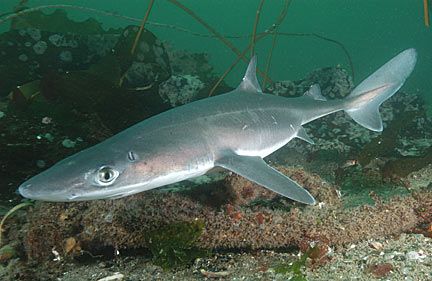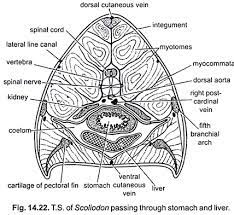Coelom and Viscera in Scoliodon: In Scoliodon the body cavity is not united, the body cavity show compartment, the body cavity has two separate compartments. Two compartments of the body cavity are unequal, the anterior body cavity is smaller and known as the pericardial cavity. The posterior body cavity is larger than the pericardial body cavity and is known as the abdominal body cavity.
A tough connective tissue membrane, septum transversum separate the anterior pericardial body cavity from the posterior larger abdominal body cavity. The pericardial body cavity and the abdominal body cavity are connected to each other through a perforation on the septum transversum known as the pericardio-peritoneal canal.

The anterior smaller pericardial body cavity host the heart, inside this body cavity heart accommodate and the pericardial body cavity is present just below the pharynx. The inner wall of the pericardial body cavity is lined by two layers of membrane. Between the two membranes a special fluid pressure known as pericardial fluid, pericardial fluid gives the inner heart protection against mechanical shock.
Other visceral organs are present inside the larger posterior part of the body cavity inside the abdominal body cavity. The abdominal body cavity is also known as the perivisceral or peritoneal body cavity and it is connected to the anterior body cavity through the pericardio-peritoneal canal.
The abdominal body cavity opens outside through a pair of pores present on the lateral body wall near the papilla of the pelvic fins. In the peritoneal cavity different important visceral organs like the alimentary canal, gonads, pancreas, liver, spleen are present. The inner wall of the perivisceral body cavity is lined by a special type of coelomic peritoneum known as the peritoneum, the peritoneum also covers the surface of the visceral organs present inside the perivisceral body cavity.
The perivisceral body cavity is filled with a colourless coelomic fluid, the visceral organs remain to hang in the coelomic fluid from the dorsal body wall with the help of mesentery. The mesentery is a wall-like structure made of two membranes, between the two membranes connective tissue present, the mesentery help in keeping the position of visceral organs to be fixed inside the perivisceral body cavity.
Different parts of the digestive system are also connected to some incomplete mesentery which helps to keep the position of all parts of the alimentary canal inside the perivisceral body cavity. So we can say that the body cavity of Scoliodon is a true coelom that is divided into two parts, anterior smaller pericardial body cavity and posterior larger abdominal body cavity.

In the pericardial body cavity the heart presents while in the perivisceral body cavity all the vital visceral organs are present, two body cavities are connected to each other with the help of a pericardio-peritoneal canal.
The inner surface of the pericardial body cavity is lined by the double layer of pericardium while in the perivisceral body cavity the inner wall is lined by the peritoneum, the perivisceral body cavity is filled with a colourless coelomic fluid. The perivisceral body cavity is connected to the outside through the paired abdominal pores present on the lateral side of the body near the pelvic fins. Inside the perivisceral body cavity, all the visceral organs are connected to the mesentery and remain in a suspended state from the dorsal body wall.

Scoliodon is a marine cartilaginous fish generally found in almost all oceans, they are also known as Dogfish or black sharks due to their dark coloured body skin. In South India they are popular in the name of black shark, the body surface is slimy due to the presence of mucous gland in the epidermis, the pigment cells present below the epidermis give the dark colouration to their skin.
On the lower surface, the body is pale white and the dorsal dark colouration help them in camouflage in the marine water. Dogfish are fast swimmers and they chase their prey, capture the prey with the help of backward directed sharp teeth.
Detailed Study On
Placoid Scales In Scoliodon (Exoskeleton)
Skin of Scoliodon (Integument)
External Morphology of Scoliodon
Scoliodon: Habits Habitat and Geographical Distribution
Hi Everyone!!! Welcome to Imaluop. Imaluop always try to learn some new and he want to share to other people. Here we will try to learn various topics on Science, specially on Biological Sciences.